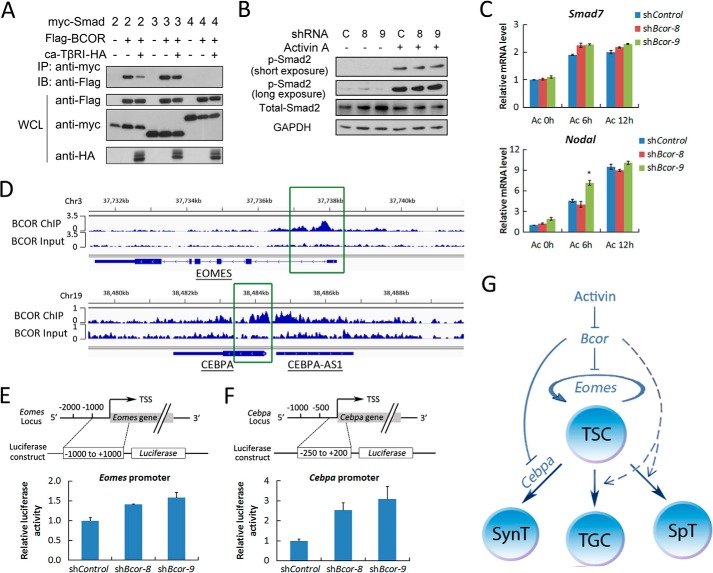FIGURE 6.
BCOR regulates TSC self-renewal and differentiation by inhibiting Eomes and Cebpa. A, HEK293FT cells were co-transfected with constructs carrying Smads, BCOR, and active TGF-β type I receptor (ca-TβRI) as indicated for 48 h before they were harvested. Cell lyses were precipitated with anti-Myc antibody, followed by anti-FLAG immunoblotting (IB) to detect the interaction between BCOR and Smads. IP, immunoprecipitation; WCL, whole cell lysate. B and C, self-renewing cells were starved in TS+F4H medium for 12 h and then treated with 25 ng/ml activin A for the indicated times. The Smad2 phosphorylation level (B, p-Smad2) or the mRNA levels of Nodal and Smad7 (C) are shown. D, the binding of BCOR to EOMES and CEBPA promoters based on the ChIP sequencing of Huang et al. (42). E and F, luciferase reporter constructs with indicated Eomes or Cebpa promoter regions (upper panel) were transfected into TSCs cultured in self-renewal condition, and the cells were harvested 48 h after transfection and then subjected to luciferase activity determination. G, schematic model for the function of activin signaling in controlling mouse TSC fate through down-regulating Bcor. Activin inhibits the expression of Bcor, which in turn negatively regulates TSC self-renewal and syncytiotrophoblast differentiation through down-regulating Eomes and Cebpa. The solid line indicates direct effect, while the dotted line indicates unclear mechanisms. The dark blue line and cycle represent differentiation and self-renewal, respectively. TGC, trophoblast giant cells; SynT, syncytiotrophoblasts; SpT, spongiotrophoblasts. Data are presented as mean ± S.E. (n = 3; *, p < 0.05).

